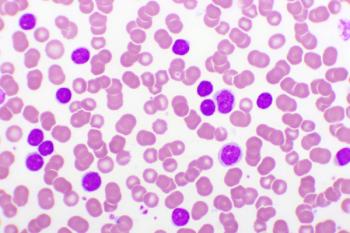
Addressing Comorbidities in Patients With Psoriatic Disease: Jennifer Soung, MD
Some comorbidities associated with psoriatic disease can be treated with GLP-1 RAs and multidisciplinary care.
Psoriatic disease has been associated with a significant increase in risk for cardiometabolic comorbidities like obesity, hypertension, diabetes, and cardiovascular disease.1
Jennifer Soung, MD, a board-certified dermatologist who leads clinical research at Southern California Dermatology, also specializes in treating patients with psoriatic disease. With the overlap of comorbidities associated with psoriatic disease, Soung said in an interview with The American Journal of Managed Care® that she finds herself working with obesity medicine and primary care specialists to manage patient care.
Furthermore, with the rise of glucagon-like peptide-1 receptor agonists (GLP-1 RAs), she’s become more involved with patient weight loss and managing patients’ weight than she was before.
“With the invention of GLPs, this has really expanded our multidisciplinary care to also include someone who's managing their weight. Maybe an obesity specialist or maybe their primary care doctor,” Soung said.
Soung also spoke at the 2025 Skin of Color Update, addressing multidisciplinary approaches to treating comorbidities in patients with psoriasis and the role of GLP-1 RAs in treatments. She and another panelist explained how adipose tissue can contribute to more inflammation in patients with psoriasis and hidradenitis suppurativa.
“You know that psoriasis patients are [more often] overweight, and it's a problem; the overweight contributes to all of these other systemic health conditions, and now is when we treat with the GLP-1 RAs,” she said.
Patients with a high body mass index are more susceptible to comorbidities associated with psoriasis, as Soung said; both states of chronic inflammation feed off of one another. Adipose tissue acts as an active endocrine organ and part of the immunometabolism system, releasing signaling molecules known as adipokines, which, when dysregulated, can contribute to weight gain.
“Beyond [GLP-1 RAs], nutrition, exercise, and behavioral counseling are all important components to help because it is truly a systemic disease,” Soung said.
This transcript was lightly edited. Captions are auto-generated.
Transcript
How do you manage comorbidities in patients with psoriatic disease, especially those that can exacerbate the underlying condition?
I would probably say the obesity part. When I think of psoriatic disease from a dermatologist’s perspective, we have great tools to manage their skin now, and most of the time, our patients are clear, almost clear, or doing well. And what I find is that patients who have other health problems that are not managed well—especially obesity or diabetes, for example, are two that are prominent in my mind—is that their psoriasis can be a little more active, meaning that they may achieve a primary response or clearance at some point.
In the long term, they may fluctuate a little bit, which means that they can have a couple of lesions, residual lesions, or recurrence of lesions, and I find that this is where that residual inflammation comes from, he other parts of their health that are not as well optimized. I call that biologic survival or the maintenance or durability of a response. I think that will be that obesity or weight contributes to that inflammation.
Where are the biggest evidence gaps right now in linking obesity, metabolic disease, and dermatologic conditions?
You know that psoriasis patients are [more often] overweight, and it's a problem; the overweight contributes to all of these other systemic health conditions, and now, when we treat with the GLP-1 RAs, or what outcomes are we improving?
We've seen in internal medicine that a GLP-1 RA, or simply significant weight loss—more than 10%—improves high blood pressure, diabetes, lowers your cholesterol, and may help with fatty liver as well, right? Then the last question from a dermatologist's perspective is, is it helping the skin? There's some early evidence that GLP-1 RAs have a direct anti-inflammatory effect on the immune cells that contribute to inflammation and psoriasis. When we treat the patient in this comprehensive approach, we're now going to address the skin, the joints, and all of the metabolic conditions. Now we're kind of just waiting for the evidence.
There are studies being conducted now [comparing] patients who are taking a GLP-1 RA for their plaque psoriasis with a biologic vs no GLP-1 RA. We're going to see, does the addition of the GLP-1 RA improve further skin clearance? I'm sure it's going to improve their overall health, and so even without further improving their skin, I see it as beneficial for the patients.
How do you see glucagon-like peptide-1 receptor agonists being used to treat patients with chronic inflammatory skin diseases?
I think GLP-1 RAs are a new tool that is so powerful in helping our patients lose weight and become healthier. I mean, that's really the goal, helping our patients become healthier as a whole. Beyond the skin, we're addressing all the other sources of inflammation and helping them with their metabolic conditions.
Now, if we're talking about just skin, we're waiting to see the evidence, and I think, again, it's a dual approach when you're treating inflammation, and that the GLP-1 RAs potentially treat that residual inflammation, even beyond being on a biologic that's targeting the skin.
What strategies do you find work best when discussing the potential link between psoriatic disease and weight with patients?
Talking about weight with patients can be really tricky. It's a sensitive topic. Weight or obesity has a lot of social stigma. It's also really personal, so it can be emotional. I think the best way is really starting off with asking permission. There's actually a framework for talking about this called the 5 A's. Start with the first one, which is Ask: “Would it be okay if we talked about your weight today?” Or, “I'm worried about your weight impacting your health and your skin.”
Starting with that, as a health care provider who's concerned about the patient and giving the patient the power to say and permission to say yes or no, that they want to talk about it today, I think it’s a really open and sensitive way to start the conversation.
Next is really then advising, “Hey, let's take a look at your BMI [body mass index],” and talking about [how] there is a connection between your weight and systemic inflammation and all your other health conditions. Educating the patient about that connection is really important. And then after that, evaluating, “OK, well, where do we want to start?” and creating a plan with the patient, and then implementing that.
References
1. Kumthekar A, Ogdie A. Obesity and psoriatic arthritis: a narrative review. Rheumatol Ther. 2020;7(3):447-456. doi:10.1007/s40744-020-00215-6
Newsletter
Stay ahead of policy, cost, and value—subscribe to AJMC for expert insights at the intersection of clinical care and health economics.









































